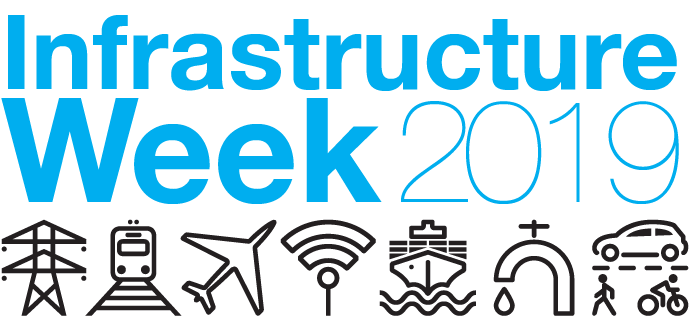
It’s Infrastructure Week 2019. Let’s #BuildForTomorrow. Starting Now.
Infrastructure isn’t partisan. It’s personal. No matter where you live, your political leanings, your age, your education, if you drive a car or a truck or take the bus or a bicycle, infrastructure has a profound impact on your daily life. We all have to get around. We all need lights to come on and water to come out of the tap. The idea that potholes aren’t partisan has been around for a while. For years, near-unanimous, bipartisan support for infrastructure investment has been steadily increasing, and leaders and voters in state houses and city have been rolling up their sleeves, making tough but important choices, and rebuilding and modernizing transportation, water, and energy systems.
But our infrastructure doesn’t exist in isolation. Infrastructure – literally – unites the United States of America. No state, city, or county can alone tackle the enormous and growing backlog of projects of regional and national importance, and Americans get it: more than 79 percent of voters think it is extremely important for Congress and the White House to work together to invest in infrastructure. We need federal leadership, we need a national vision, and we need a plan to pay for it.
Too much of our nation’s infrastructure is undermaintained, too old, and over capacity. Every four years the American Society of Civil Engineers (ASCE) issues its Infrastructure Report Card, giving the nation’s aviation systems, roads, drinking and wastewater, ports and much more near-failing grades that should at least embarrass us, if not spur national leaders to action. Americans pay a hidden tax – to the tune of $9 a day per household – while getting nothing in return.
We are being pennywise and pound foolish when we put a net under a bridge to catch falling concrete instead of rebuilding the aging, bridge in the first place. Nobody wants to spend an average of 42 hours a day sitting in traffic. Our airplanes still navigate using WWII-era air-traffic control systems, and our ports struggle to keep up with an economy that increasingly demands just-in-time deliveries to compete in the global economy. Aged and overstretched drinking water and wastewater systems have contributed to weeks-long boil-water advisories and business shutdowns in Texas and Ohio; droughts in western states have caused wells and reservoirs to fall dangerously low; saltwater intrusion of Florida’s drinking water infrastructure, and dam and levee failures in California, South Carolina, and Louisiana have caused evacuations and put hundreds of thousands of people and homes at risk.
That’s the alarm bell – but what about the opportunity? Even where infrastructure isn’t the problem, innovative policies, technologies, and investments can be the solution to so many challenges. Smart investments in transportation infrastructure not only create good-paying jobs in construction but also expand access to jobs and affordable housing across cities and regions. Better transportation infrastructure shortens commutes, reduces health-threatening congestion, and increases both worker productivity and family and leisure time. Affordable, reliable, clean water attracts new businesses from breweries to manufacturers. Modernizing and maintaining ports and supply chain infrastructure increases productivity, mitigates business risk, and lowers the costs of raw materials, food, and consumer goods. Investments in resilient infrastructure allow emergency responders to get to areas impacted by hurricanes, floods, fires and other disasters faster, helps communities recover faster, and, of course, it is more fiscally responsible to build once the right way instead of rebuilding repeatedly.
May 13-20, 2019 is the seventh annual Infrastructure Week – a national week of advocacy and education that brings together business, labor, and elected leaders to spotlight the need to revitalize, modernize, and invest in infrastructure. Many communities around the country are working hard to deliver projects the solve local problems. In Washington, DC, pedestrians remain at high risk on the region’s roads; pedestrians accounted for one-third of the 290 traffic deaths in the greater Washington areas in 2018. In response to this challenge, District Department of Transportation chief (DDOT) Jeff Marootian told WAMU that his agency may install concrete barriers on Florida Avenue NE to expand safe space for pedestrians and cyclists and reduce vehicular lanes.
But such efforts are only a piece of the solution. For two centuries, the federal government was the catalyst for the infrastructure projects that transformed America, made us a superpower, and built the middle class. Federal policy and public and private investment built the transcontinental railroad, the Panama Canal, the interstate highway system, and huge dams and the electric grid. We need leadership with vision and courage to tackle big projects again. This country can accomplish the unimaginable when we put our mind to it. We have to reignite that spark of innovation and ambition and demand bold leadership to do what we know can – and must – be done. It is time to retire our old bad habits, to reject short-sighted thinking, and finally start to build for tomorrow.
